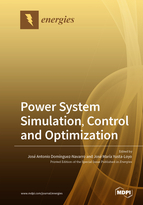Power System Simulation, Control and Optimization
A special issue of Energies (ISSN 1996-1073). This special issue belongs to the section "F: Electrical Engineering".
Deadline for manuscript submissions: closed (30 September 2020) | Viewed by 32393
Special Issue Editors
Interests: electrical network planning; renewable energy integration; application of computing techniques (neural networks, fuzzy systems and heuristic optimization algorithms)
Special Issues, Collections and Topics in MDPI journals
Interests: energy markets; optimal dispatch of smart grids; vulnerability assessment of critical infrastructure
Special Issues, Collections and Topics in MDPI journals
Special Issue Information
Dear Colleagues,
The analysis, operation and control of power systems are increasingly complex tasks that require advanced simulation models to analyze and control the effects of transformations concerning electricity grids today: massive integration of renewable energies, progressive implementation of electric vehicles, development of intelligent networks, and progressive evolution of the applications of artificial intelligence.
This Special Issue aims to group all the alternative paradigms that are being developed to go beyond the current simulation and control programs. These include, in particular but not exclusively:
- Multi-agent systems;
- Parallel programming;
- Heuristic techniques;
- Optimization algorithms;
- Neural networks and Deep learning;
- Fuzzy systems.
Prof. Dr. José Antonio Domínguez-Navarro
Prof. Dr. José María Yusta-Loyo
Guest Editors
Manuscript Submission Information
Manuscripts should be submitted online at www.mdpi.com by registering and logging in to this website. Once you are registered, click here to go to the submission form. Manuscripts can be submitted until the deadline. All submissions that pass pre-check are peer-reviewed. Accepted papers will be published continuously in the journal (as soon as accepted) and will be listed together on the special issue website. Research articles, review articles as well as short communications are invited. For planned papers, a title and short abstract (about 100 words) can be sent to the Editorial Office for announcement on this website.
Submitted manuscripts should not have been published previously, nor be under consideration for publication elsewhere (except conference proceedings papers). All manuscripts are thoroughly refereed through a single-blind peer-review process. A guide for authors and other relevant information for submission of manuscripts is available on the Instructions for Authors page. Energies is an international peer-reviewed open access semimonthly journal published by MDPI.
Please visit the Instructions for Authors page before submitting a manuscript. The Article Processing Charge (APC) for publication in this open access journal is 2600 CHF (Swiss Francs). Submitted papers should be well formatted and use good English. Authors may use MDPI's English editing service prior to publication or during author revisions.
Keywords
- Power system modeling
- Soft computing techniques
- Optimization algorithms
- Renewable energies







